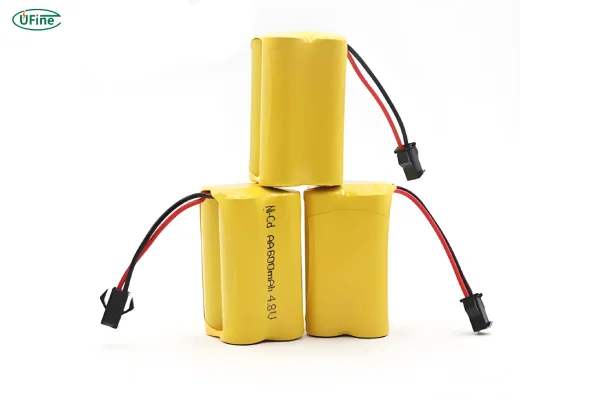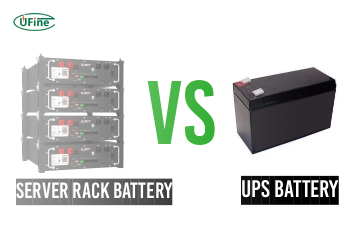
- Part 1. What is a NiCd battery?
- Part 2. Chemistry
- Part 3. Voltage
- Part 4. Advantages of NiCd batteries
- Part 5. Disadvantages of NiCd batteries
- Part 6. NiCd battery vs lithium battery
- Part 7. NiCd battery vs NiMH battery
- Part 8. Applications
- Part 9. Charger
- Part 10. Can I replace NiCd batteries with lithium batteries?
Part 1. What is a NiCd battery?

A NiCd battery (Nickel-Cadmium battery) is a rechargeable power source with a long history of reliability and versatility. Widely used in various industries, NiCd batteries are known for their ability to handle high discharge rates, durability, and cost-effectiveness. But what exactly makes this technology stand out?
A typical NiCd battery consists of two main electrodes: the positive electrode (nickel oxide hydroxide) and the negative electrode (cadmium). These electrodes are submerged in an alkaline electrolyte that facilitates the movement of ions during the charging and discharging cycles. This simple yet effective structure allows NiCd batteries to provide consistent performance in numerous devices, from power tools to RC vehicles.
One of the unique features of NiCd batteries is their ability to endure deep discharge cycles. Unlike some other rechargeable batteries, NiCd can go through many charge and discharge cycles without losing its performance, which makes it an attractive option for applications that require long-lasting energy.
Part 2. Chemistry
At the core of the NiCd battery lies its chemistry, which is integral to its performance and longevity. The positive electrode, nickel oxide hydroxide (NiOOH), reacts with the negative electrode, cadmium (Cd), during the discharge process. When the battery is discharged, cadmium releases electrons, and nickel hydroxide undergoes reduction.
When charging the battery, the process is reversed. This allows the NiCd battery to be recharged multiple times, providing users with a reliable power source. Despite being widely replaced by newer technologies in some markets, the NiCd battery is still preferred in specific environments that demand durability and high discharge rates.
Part 3. Voltage
The voltage of a NiCd battery is a critical factor in determining its performance and suitability for various applications. Generally, a NiCd battery provides 1.2V per cell, which is slightly lower than other rechargeable batteries like Li-ion or LiPo batteries. However, despite its lower voltage, the NiCd battery offers a stable output over its discharge cycle, meaning that devices powered by NiCd batteries can run efficiently for a long time.
A NiCd battery pack is often made up of several cells arranged in series, depending on the required voltage for a particular application. For example, a 10-cell NiCd pack provides 12V (10 x 1.2V), making it ideal for devices like power tools, RC cars, and emergency backup systems.
While the voltage remains relatively stable throughout the discharge cycle, NiCd batteries will experience a slight dip towards the end of their charge. This behavior makes it important to monitor charge levels closely to prevent over-discharge, which can shorten the battery’s lifespan.
Part 4. Advantages of NiCd batteries
Despite being somewhat overshadowed by newer battery technologies, NiCd batteries offer several distinct advantages that make them an attractive choice for specific applications. Let’s explore some of the most notable benefits:
-
Durability and Toughness: One of the most significant advantages of NiCd batteries is their exceptional durability. These batteries can withstand harsh conditions, including high-impact situations, extreme temperatures, and physical stress. This makes them ideal for applications like power tools and RC vehicles, where ruggedness is a must.
-
High Discharge Rate: NiCd batteries are capable of delivering a high discharge rate. This means they can provide rapid bursts of power when required. This is especially useful for devices like cordless power tools that require sudden surges of energy to operate efficiently.
-
Performance in Extreme Temperatures: NiCd batteries have a remarkable ability to function in both high and low temperatures. Whether it’s the scorching heat of a summer day or the cold chill of winter, NiCd can operate where other batteries might fail. This makes them suitable for use in outdoor equipment and aviation devices, where temperature fluctuations are a constant challenge.
-
Long Shelf Life: Another major plus of NiCd batteries is their long shelf life. When stored properly in a discharged state, these batteries can remain functional for years, making them a reliable option for emergency backup systems or tools that may not be used frequently.
Part 5. Disadvantages of NiCd batteries
While NiCd batteries have many advantages, they also come with a few notable drawbacks. Understanding these limitations is crucial to making an informed decision about whether to choose NiCd for your specific needs.
-
Memory Effect: One of the most well-known issues with NiCd batteries is the memory effect. This occurs when the battery is repeatedly charged without being fully discharged. Over time, the battery “remembers” this shorter cycle, and its overall capacity decreases. This means the battery will hold less charge, reducing its effective runtime.
-
Toxicity: NiCd batteries contain cadmium, a toxic metal that can be harmful to the environment. Improper disposal can lead to contamination, making NiCd batteries less environmentally friendly compared to other chemistries like Li-ion or NiMH. It’s essential to recycle NiCd batteries properly to minimize environmental impact.
-
Lower Energy Density: In terms of energy storage, NiCd batteries have a lower energy density compared to more modern battery types like Li-ion. This means they tend to be heavier and bulkier for the same amount of power, which can make them less suitable for applications that require lightweight solutions.
-
Higher Self-Discharge Rate: NiCd batteries also suffer from a higher self-discharge rate compared to newer technologies. This means they tend to lose their charge more quickly when not in use, which can be inconvenient for users who want to store their batteries for extended periods.
Part 6. NiCd battery vs lithium battery
When comparing NiCd batteries to Li-ion batteries, there are several key differences to consider:
-
Energy Density: Li-ion batteries are much lighter and have a higher energy density, meaning they can store more energy in a smaller and lighter package compared to NiCd batteries.
-
Memory Effect: NiCd batteries suffer from the memory effect, while Li-ion batteries do not, making them more forgiving in terms of charging habits.
-
Environmental Impact: Li-ion batteries are generally considered less toxic than NiCd batteries, especially with regards to their cadmium content. However, Li-ion batteries still require careful disposal and recycling.
-
Cost: NiCd batteries tend to be cheaper than Li-ion batteries, which makes them a more affordable option for certain budget-conscious applications.
-
Performance Over Time: Li-ion batteries generally maintain their performance over a more extended period, while NiCd batteries may suffer from capacity loss due to the memory effect.
Part 7. NiCd battery vs NiMH battery
Another common comparison is between NiCd and NiMH (Nickel-Metal Hydride) batteries. Both share similar chemistries but differ in several ways:
-
Energy Density: NiMH batteries have a higher energy density than NiCd, meaning they can store more energy while being lighter and more compact.
-
Memory Effect: NiMH batteries have a much smaller memory effect compared to NiCd batteries, which allows them to maintain their performance over time with less strict charging practices.
-
Toxicity: NiMH batteries are more environmentally friendly than NiCd because they do not contain cadmium.
-
Cost: NiCd batteries are typically cheaper than NiMH batteries, making them an affordable option for applications where high capacity isn’t the primary concern.
Part 8. Applications
NiCd batteries are used in many applications that require durability, reliability, and the ability to withstand harsh conditions. Some of the most common uses include:
- Power Tools: Cordless drills, saws, and grinders rely on NiCd batteries for consistent performance and high discharge rates.
- RC Vehicles: Many remote-controlled cars and airplanes still use NiCd batteries for their robust and reliable power delivery.
- Medical Devices: Some medical equipment like portable ventilators and heart defibrillators use NiCd batteries due to their ability to provide consistent power and their long shelf life.
- Consumer Electronics: NiCd batteries can still be found in cordless phones and cameras.
Part 9. Charger
Charging a NiCd battery requires a special charger designed for this battery type. NiCd chargers typically have the following features:
-
Delta-V Cutoff: This mechanism detects the voltage drop at the end of a charge cycle to prevent overcharging.
-
Trickle Charge: After reaching full charge, a trickle charge is used to keep the battery at full capacity without overcharging.
-
Constant Current/Constant Voltage Charging: Some chargers provide constant current until the voltage reaches a preset level, after which they switch to a constant voltage to finish charging.
Part 10. Can I replace NiCd batteries with lithium batteries?
Replacing NiCd batteries with Li-ion batteries is often possible, but not always straightforward. While the voltage and capacity might match, it’s important to consider other factors like charging characteristics and battery management systems. Simply swapping out a NiCd battery for a Li-ion may result in malfunction or damage if the device isn’t designed to handle the new battery type
Before replacing your NiCd battery with a Li-ion, make sure to consult the device’s manufacturer for compatibility or consider using a battery conversion kit.
Related Tags:
More Articles

Server Rack Battery vs UPS Battery: What’s the Difference
Discover the difference between server rack and UPS batteries. Compare design, chemistry, performance, and maintenance to select the best data center backup.
How to Choose the Right Server Rack Battery for Your Data Center?
Find out how to choose the right server rack battery for your data center. Consider capacity, runtime, safety, and compatibility for reliable backup power.
What Is a Server Rack Battery? A Complete Guide for Data Centers and IT
Discover what a server rack battery is, how it works, and why it’s essential for reliable data center and IT power backup. Learn key features and benefits.
Understanding the Difference Between AA and AAA Batteries
Wondering about the difference between AA and AAA batteries? Learn the key differences, similarities, and when to use each in this detailed guide.
3S LiPo Batteries Explained – How to Pick the Best 3S Battery
This guide includes 3S voltage charts, capacity options, life, safety rules, and top recommended batteries — so you can choose the best 3S LiPo battery.


